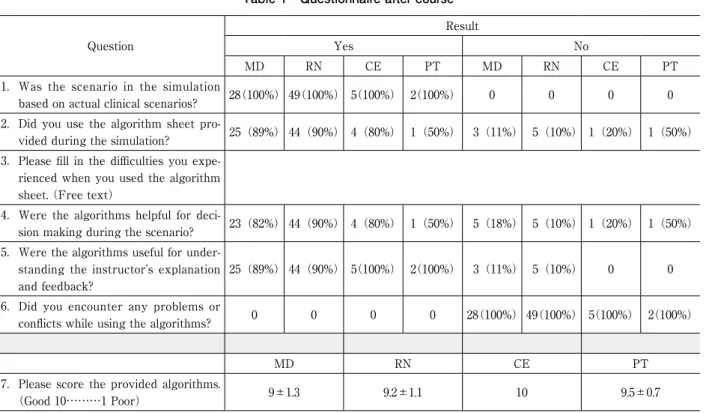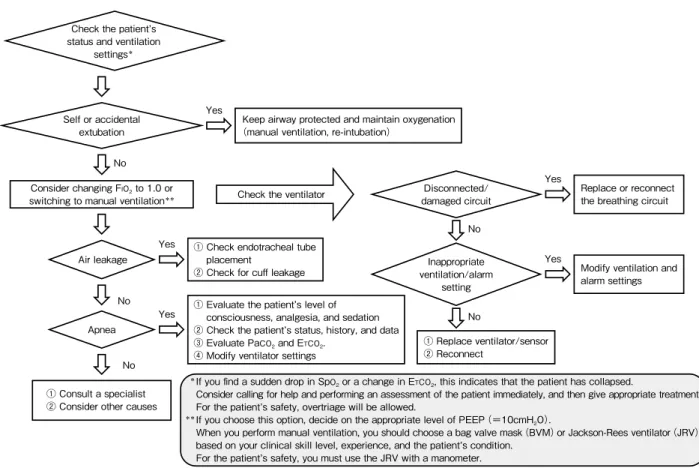◉
短 報
◉
1)岐阜大学医学部附属病院 看護部
2)同 高次救命治療センター
3)一宮市民病院 救命救急センター 救急科
[受付日:2015 年 1 月 6 日 採択日:2016 年 7 月 25 日]
Ⅰ.緒 言
人工呼吸器アラームの原因と対応の理解は、トラブ
ルの予防と異常の早期認識に繋がる。しかし、アラー
ム対応は医療者の経験年数や知識・技術などに大きく
影響される。安全な人工呼吸管理を行ううえで、アラ
ーム時のトラブル対応の教育は重要である。
人工呼吸器アラーム対応に関する教育として、シミ
ュレーション教育は、各施設でさまざまな教育手法が
用いられている
1)。
我々も、人工呼吸器アラーム対応シミュレーション
教育の学習支援ツールとして作成したアルゴリズム表
を用いることで、一定レベルでのアラーム対応の理解
と学習効果の向上に繋がる可能性があると考え、アン
ケート調査を実施した。
Ⅱ.研究の目的
一定レベルの知識や技術の習得を行うことを目的と
して、アルゴリズム表を作成しシミュレーション教育
を行った。作成したアルゴリズム表が、人工呼吸器ア
ラーム対応シミュレーション教育の学習支援ツールと
して使用可能であるか否かについて検討する。
Ⅲ.研究対象者
NPO 法人岐阜救急災害医療研究開発機構が過去 2 回
(2013 ~ 2014 年)開催した人工呼吸器セミナーを受講
したさまざまな施設に所属する医師(以下:MD)、看
護師(以下:RN)、臨床工学技士(以下:CE)、理学
療法士(以下:PT)の 84 名とした。
Ⅳ.研 究 方 法
1.アンケートの方法
人工呼吸器アラーム対応シミュレーション終了後
に、シミュレーション内容とシミュレーション中のア
ルゴリズム表の使用について、「はい」「いいえ」の 2
者択一とアルゴリズムの完成度を 10 点尺度で採点す
る無記名のアンケート調査を行った(Table 1)。また、
アンケート結果は単純集計した。
2.人工呼吸器アラーム対応のシミュレーション
生体モニターを装着したシミュレーター人形にグラ
フィックモニター搭載型人工呼吸器を接続した。
人工呼吸器アラーム対応シミュレーションは、「気
道閉塞」「緊張性気胸」「片肺挿管」「リーク」のシナ
リオから無作為に選択して 70 分間で可能な限り実施
した。各シナリオは、フィードバック(以下:FB)を
含めて 10 ~ 15 分で行った。
シナリオの進行と FB は、岐阜大学医学部附属病院
高次救命治療センター所属の医師 4 名と同院所属の集
中ケア認定看護師 2 名が行った。
FB は、各シナリオ終了後にアラーム発生時の原因
検索の方法や手順、アラームに対してどのように対応
する必要があるかについて、アルゴリズム表を使用し
アルゴリズム表を用いた人工呼吸器アラーム対応シミュレーション教育
林 賢二
1, 2)・吉田省造
2)・杉原博子
1, 2)・山田法顕
2)土井智章
2, 3)・名知 祥
2)・牛越博昭
2)・小倉真治
2)キーワード:人工呼吸器,アルゴリズム,シミュレーション教育,トラブル,医療安全,チーム医療
て受講生と双方向的に行った。
3.アルゴリズム表
人工呼吸器アラーム対応のアルゴリズム表は、本セ
ミナーにおけるシミュレーション教育を行う際に考え
方を構築するための学習支援ツールとして作成した。
人工呼吸器には複数のアラームが表示される。アラ
ームの分類は、日本呼吸療法医学会「人工呼吸器安全
使用のための指針第2版」、厚生労働省告示第264号「人
工呼吸器警報基準」、日本看護協会医療・看護安全管
理情報「人工呼吸器による事故を防ぐ」、日本臨床工
学技士会「医療スタッフのための人工呼吸療法におけ
る安全対策マニュアル Ver.1.10」、「Mechanical
Venti-lation FIFTH EDITION」を参考に作成した。
アルゴリズム表は①気道内圧上限アラーム(Fig.1)、
②分時換気量上限・呼吸回数上限アラーム(Fig.2)、
③気道内圧低下・分時換気量下限・無呼吸アラーム
(Fig.3)の 3 項目に分類して作成した。また、アラー
ムの原因が患者か人工呼吸器のトラブルかによって対
応が異なるため、患者側と機器側に分けて表記した。
アルゴリズム表は、受講者にアルゴリズムの解説は
行わずにシミュレーション開始時に手渡した。また、
シミュレーション中にアルゴリズム表を活用してよい
旨を伝え、アルゴリズム表の使用は受講者の自由とし
た。
Ⅴ.倫理的配慮
岐阜大学医学部附属病院看護部倫理小委員会の承認
を得て実施した。アンケートは完全無記名で施行し、
アンケート用紙の提出によって本研究参加に同意が得
られたものとする旨を口頭で説明した。
Ⅵ.アンケート結果
1.対象者の背景
対象者は、MD:28 名、RN:49 名、CE:5 名、PT:
2 名の 84 名であった。臨床経験年数は、1 年未満:28
名(33%)、2 ~ 5 年:30 名(36%)、6 ~ 10 年:16 名
(19%)10 年以上:6 名(7%)、未回答:4 名(5%)で
あった。
2.アルゴリズム表を用いたシミュレーション教育
シミュレーション中にアラームの原因検索や対応の
判断にアルゴリズム表を使用した受講者は、全体の 74
名(88%)であった(Table 1)。また、アルゴリズム
Question
Result
Yes
No
MD
RN
CE
PT
MD
RN
CE
PT
1. Was the scenario in the simulation
based on actual clinical scenarios?
28(100%) 49(100%) 5(100%) 2(100%)
0
0
0
0
2. Did you use the algorithm sheet
pro-vided during the simulation?
25(89%) 44(90%) 4(80%) 1(50%) 3(11%) 5(10%) 1(20%) 1(50%)
3. Please fill in the difficulties you
expe-rienced when you used the algorithm
sheet. (Free text)
4. Were the algorithms helpful for
deci-sion making during the scenario?
23(82%) 44(90%) 4(80%) 1(50%) 5(18%) 5(10%) 1(20%) 1(50%)
5. Were the algorithms useful for
under-standing the instructor’s explanation
and feedback?
25(89%) 44(90%) 5(100%) 2(100%) 3(11%) 5(10%)
0
0
6. Did you encounter any problems or
conflicts while using the algorithms?
0
0
0
0
28(100%) 49(100%) 5(100%) 2(100%)
MD
RN
CE
PT
7. Please score the provided algorithms.
(Good 10………1 Poor)
9±1.3
9.2±1.1
10
9.5±0.7
MD:medical doctor, RN:registered nurse, CE:clinical engineer, PT:physical therapist
Check the ventilator Yes Yes Yes No No No Airway/ endotracheal tube problem Pneumothorax Coughing/ bucking any rales
Check the patient s status and ventilation
settings*
Consider changing FIO2 to 1.0 or
switching to manual ventilation**
① Remove the obstruction/kink ② Reposition the tube ③ Treat bronchospasm ④ Modify analgesia/sedation
Treat pneumothorax (i.e., insert chest tube)
Remove the cause(s) (i.e., modify sedation/analgesia,
suction, humidification)
Yes
No
No Breathing circuit trouble (obstruction, kink) Heat and moisture exchanger
(HME) obstruction
① Remove the cause(s) of the obstruction/kink ② Replace the HME
Yes Inappropriate
alarm setting Modify alarm settings
① Replace the ventilator/sensor ② Reconnect
① Consult a specialist ② Consider other causes
*If you find a sudden drop in SpO
2 or a change in ETCO2, this indicates that the patient has collapsed.
Consider calling for help and performing an assessment of the patient immediately, and then give appropriate treatment. For the patient s safety, overtriage will be allowed.
**If you choose this option, decide on the appropriate level of PEEP(=10cmH
2O).
When you perform manual ventilation, you should choose a bag valve mask(BVM)or Jackson-Rees ventilator(JRV) based on your clinical skill level, experience, and the patient s condition.
For the patient s safety, you must use the JRV with a manometer.
Fig. 1 Algorithm for the ‘high airway pressure alarm’.
(Gifu University Hospital Ver. 2.0)Fig. 2 Algorithm for the ‘high minute volume/respiratory rate alarm’.
(Gifu University Hospital Ver. 2.0) No No No No Yes Yes Yes Yes Coughing/ bucking Tachypnea/ hyperventilation/ increased effort ① Consult a specialist ② Consider other causesRemove causes
(suction, modify analgesia and sedation, humidification)
Evaluate the patient s level of consciousness, analgesia, and sedation (the patient s status, history, and data should be checked)
Water/airway secretions in the
circuit
① Replace the ventilator/sensor ② Reconnect
Remove the fluid/ secretions in the circuit
Modify ventilation and alarm settings Check the patient s
status and ventilation settings*
Check the ventilator
Inappropriate ventilation/alarm
setting Consider changing FIO2 to 1.0 or
switching to manual ventilation**
*If you find a sudden drop in SpO
2 or a change in ETCO2, this indicates that the patient has collapsed.
Consider calling for help and performing an assessment of the patient immediately, and then give appropriate treatment. For the patient s safety, overtriage will be allowed.
**If you choose this option, decide on the appropriate level of PEEP(=10cmH
2O).
When you perform manual ventilation, you should choose a bag valve mask(BVM)or Jackson-Rees ventilator(JRV) based on your clinical skill level, experience, and the patient s condition.
表がアラームの原因や対応の判断に役立ったとしたの
は、72 名(86%)であった。自由記載には、「アラー
ムへの対応を冷静に行うことができた」「困った時の
参考になり、持っていると安心する」などの回答があ
った。一方、アルゴリズム表を使用しなかった主な理
由として、「シミュレーション中に見る余裕がなかっ
た」や「アルゴリズム表の内容は適切だが、実際の場
面では見る余裕がない」などが自由記載に示された。
3.FB におけるアルゴリズム表の使用について
FB 時にアルゴリズム表が有効であったかとの問い
に対して、全体の 76 名(90%)が有効であったと回
答した(Table 1)。自由記載には、「アルゴリズム表
があることで頭の整理に繋がった」「人工呼吸管理の
経験が少ないのでアルゴリズム表があると理解しやす
い」「急変対応に丁度良い」「各項目に分かれていたの
で理解しやすかった」「病棟や緊急時に使用できる」
との回答があった。
Ⅶ.考 察
シミュレーション教育は、実際の臨床現場・臨床場
面を模擬的に再現した学習環境を提供し、学習者の模
擬体験から医療者としての知識・技術・態度の統合を
目指す教育とされている
2)。
本シミュレーション教育は背景が異なる受講者を対
象に行ったが、人工呼吸器アラームの原因検索や判断
に役立ったという結果からも、アルゴリズム表を使用
することで、受講者の背景に左右されることなく、一
定レベルの学習を可能とする支援ツールになった可能
性があると考える。
FB の目的は、①受け手の手技や知識の向上を促す
ため、②受け手の学ぶ意欲を促すため、③周囲の受講
者の学びを促すためとされている
3)。このように、学
習効果を高めるには、学習支援ツールを含めた学習環
境を整えるとともに、的確な FB が重要である。各シ
ナリオの終了時に行った FB では、受講者の 76 名(90
%)がアルゴリズム表の使用が FB 時のアラーム対応
のさらなる理解に有効であったと回答しており、アル
Fig. 3 Algorithm for the ‘low airway pressure, low minute volume, or apnea alarm’.
(Gifu University Hospital Ver. 2.0) Check the ventilatorNo No Air leakage Self or accidental extubation Apnea
Keep airway protected and maintain oxygenation (manual ventilation, re-intubation)
① Check endotracheal tube placement
② Check for cuff leakage ① Evaluate the patient s level of
consciousness, analgesia, and sedation ② Check the patient s status, history, and data ③ Evaluate PaCO2 and ETCO2.
④ Modify ventilator settings
Disconnected/ damaged circuit
Replace or reconnect the breathing circuit
① Replace ventilator/sensor ② Reconnect
Consider changing FIO2 to 1.0 or
switching to manual ventilation**
Inappropriate ventilation/alarm
setting
Modify ventilation and alarm settings
*If you find a sudden drop in SpO
2 or a change in ETCO2, this indicates that the patient has collapsed.
Consider calling for help and performing an assessment of the patient immediately, and then give appropriate treatment. For the patient s safety, overtriage will be allowed.
**If you choose this option, decide on the appropriate level of PEEP(=10cmH
2O).
When you perform manual ventilation, you should choose a bag valve mask(BVM)or Jackson-Rees ventilator(JRV) based on your clinical skill level, experience, and the patient s condition.
For the patient s safety, you must use the JRV with a manometer. Check the patient s
status and ventilation settings*
① Consult a specialist ② Consider other causes
Yes Yes Yes Yes Yes No No No


